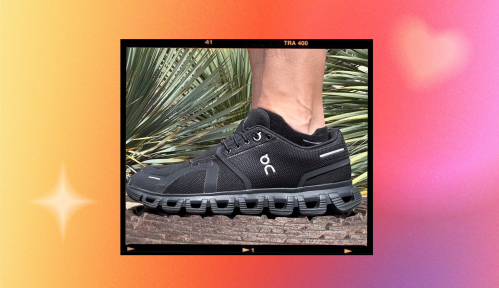There’s a reason why people tell you to breathe when your mind starts to race. When your brain is traveling a mile a minute, your body begins to follow suit (think: a speeding heartbeat, sweating palms). But there’s a mind-breath connection that has the ability to calm your senses, recenter your thoughts, and lead to greater well-being overall. It’s not just some dubious “wellness” idea, either: Studies on breathing exercises for anxiety have proven the beneficial effects of extended inhalations and exhalations on both the body and mind. For example, in 2018, researchers found that slow breathing techniques can reduce symptoms of “arousal, anxiety, depression, anger, and confusion,” and increase feelings of “comfort, relaxation, pleasantness, vigor, and alertness.”
Experts in This Article
licensed clinical psychologist and the senior director of national clinical programs at Ellie Mental Health
Intrigued? You’re not the only one. On TikTok alone, mentions of breathing exercises for anxiety have accumulated more than 100 million views. Meanwhile, mentions of specific techniques, such as the 4-7-8 breathing technique and box breathing, have earned even more interest, with doctors and everyday folks creating content to spread the word—often with helpful visuals to boot.
As much as we love scrolling through our feeds, to save you from falling down a TikTok rabbit hole, we chatted with licensed psychologist Robyn Janssen, PsyD, senior director of national programs at Ellie Mental Health, about deep breathing for anxiety. She filled us in on which breathing techniques work best to soothe an overactive mind, whether yours races in the morning or late at night.
How does breathing affect anxiety?
When we start to feel anxious, our bodies involuntarily go into fight-or-flight mode. According to the Cleveland Clinic, this stress response is “your body’s reaction to danger and was designed to help you survive stressful and life-threatening situations.” While we can’t always predict our fight-or-flight triggers, we can always fall back on our breathing in an attempt to assuage feelings of threat or danger.
“Deep breathing is a type of relaxation technique that works by increasing the amount of oxygen to your brain and, as a result, decreases anxiety,” Dr. Janssen says. “When you take in more oxygen, your heart rate slows, and your mind starts to slow down. This helps you feel grounded, more connected to your body, and quiets your mind.”
Chest vs. belly breathing
There’s a difference between regular breathing and mindful breathing. Most people naturally breathe into their chest when they’re feeling more anxious. However, if you can recenter your focus and breathe into your belly, there’s a good chance you’ll quickly start to feel better. That’s the beauty of diaphragmatic breathing, or abdominal breathing. Where chest breathing tends to be more shallow, belly breathing offers more room to expand your diaphragm and take in ample air. In doing so, belly breathing makes it easier to inhale at a slower, extended rate, which Dr. Janssen says is key for reducing anxiety.
How long does it take for deep breathing to soothe symptoms of anxiety?
Taking a single deep breath isn’t likely to cure your anxious feelings. Taking time to work your way through a full breathing exercise for anxiety, though, can pay off. The trick is to cycle through the breathing technique a few times so that you’re mindfully regulating your breath for at least a few minutes.
“While everyone experiences anxiety differently, most [experts] recommend practicing deep breathing for at least five minutes to soothe symptoms of anxiety,” Dr. Janssen says.
Guided breathing exercises for anxiety
To help arm you with plenty of breathing techniques to combat tense moments and lean out of fight-or-flight mode, ahead you’ll find a few guided breathing exercises for anxiety.
4-7-8 breathing
Perhaps the most popular breathing exercise for anxiety (at least on TikTok), the 4-7-8 breathing method involves inhaling for four seconds, holding for seven seconds, and exhaling slow and controlled for eight seconds. In addition to calming nerves, Dr. Janssen says that this breathing exercise also helps people adequately relax and prepare for sleep. (Which, BTW: Yes, you can perform the 4-7-8 breathing technique laying down. See here to learn how.)
Another benefit of the 4-7-8 breathing technique? Research shows that performing six rounds of this breathing strategy can help improve blood pressure and heart rate variability.
Square breathing or box breathing
Another deep breathing exercise that helps reduce anxiety is square breathing, aka box breathing or 4-4-4 breathing. “To perform square breathing, inhale for a count of four, hold the breath in for a count of four, and continue repeating in this manner,” Dr. Janssen says. “This can be done anywhere at any time and doesn’t have to be a part of yoga practice.”
It’s also worth mentioning that square breathing can take on different lengths, whether it be five, six, or seven seconds. Play around with your breath and find out which interval works best for you.
Diaphragmatic breathing
Diaphragmatic breathing (aka abdominal breathing) is slow and deep belly breathing that affects the brain via the autonomic nervous system. According to research, it has the potential to reduce stress, anxiety, and hypertension, as well as mitigate migraines and even chronic constipation.
To ensure that you’re breathing into your belly, place a hand on your stomach and a hand on your chest; slowly breathe into the one on your stomach. Aim for inhalations of four to five seconds long and hold it in if you can. Take your time exhaling, too—and when you do, draw your belly in toward your spine. By breathing in this slow fashion, you’ll ease your mind away from the fight-or-flight response and into a feeling of calm. Plus, it can even help strengthen your core.
Double inhale breathing
Also known as cyclic sigh breathing or the physiological sigh, double inhale breathing is the process of taking a deep inhale followed by a quick shorter breath, holding for a second, then exhaling slowly. When repeated for five minutes, this breathing modality has been shown to reduce physiological arousal in the form of respiratory rate, heart rate, and heart rate variability, while also improving mood and minimizing anxiety.
Alternate nostril breathing
Normally, we breathe through both of our nostrils. Because of this, restricting airflow to one nostril during alternate nostril breathing can awaken our senses and calm our nerves. The practice of alternate nostril breathing is nothing new, though: Alternate nostril breathing is a type of breathing sometimes used in yoga (also known as pranayama).
To perform the exercise, simply use your right thumb to close your right nostril and inhale through your left nostril. Place your right pointer finger over your left nostril, release your thumb, and exhale through your right nostril. Inhale through your right nostril, cover it, uncover your left nostril, and exhale. Repeat the process for a few minutes and take note of how your mind and body feel. As simple as it seems, research shows that it works well to activate the parasympathetic nervous system, effectively alleviating anxiety in the process.
When to talk to a doctor
While having breathing exercises on hand to combat moments of anxiousness is certainly helpful, they’re not a cure for serious anxiety. If you find that no matter how much you focus on your breathing, your anxiety continues to creep into your chest and shoulders and simply won’t budge, you should consult a doctor to talk about the best next steps. Your body and mind deserve it.
Sign Up for Our Daily Newsletter
Get all the latest in wellness, trends, food, fitness, beauty, and more delivered right to your inbox.
Got it, you've been added to our email list.











